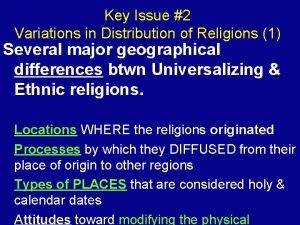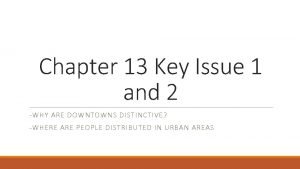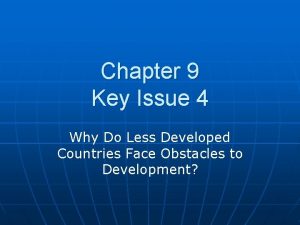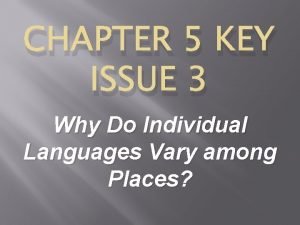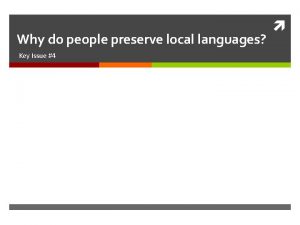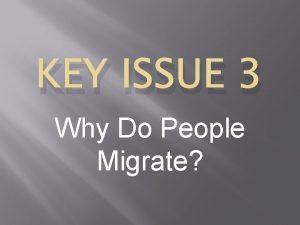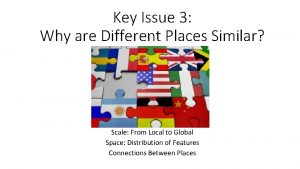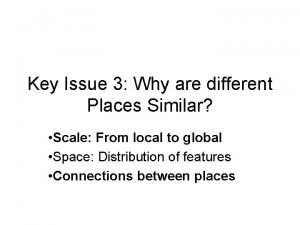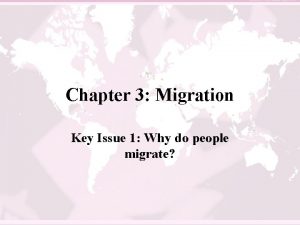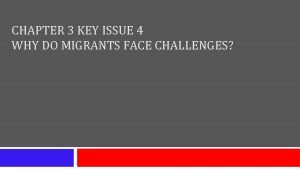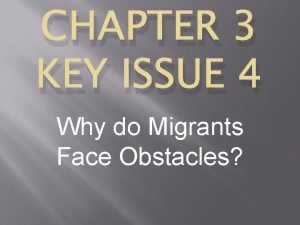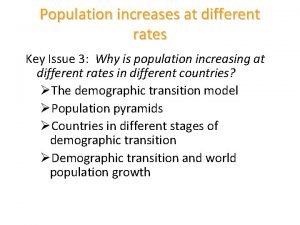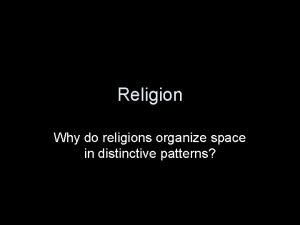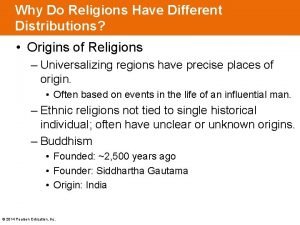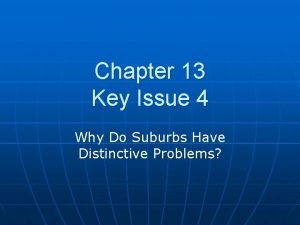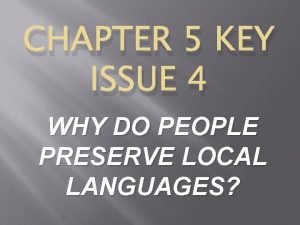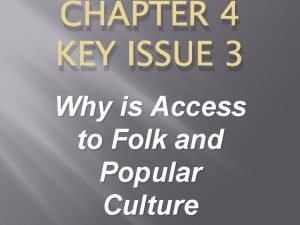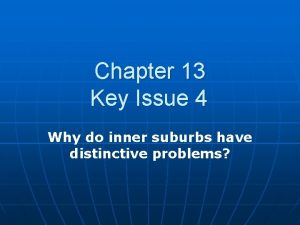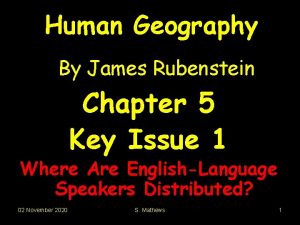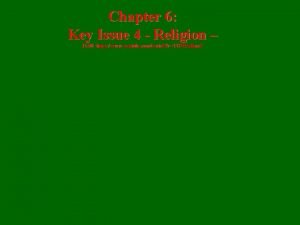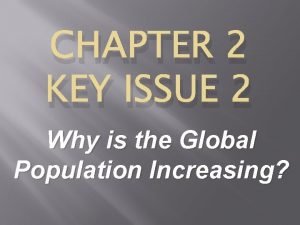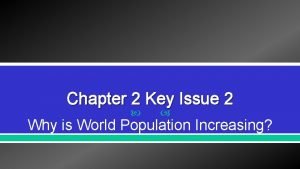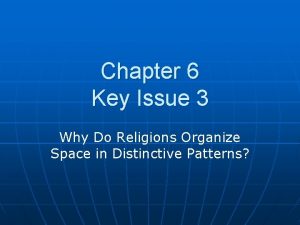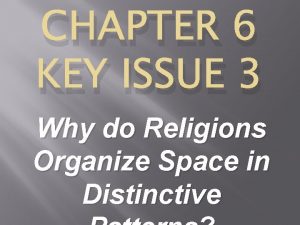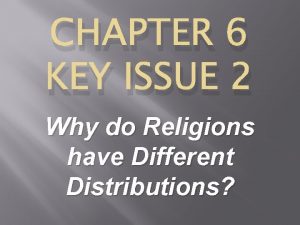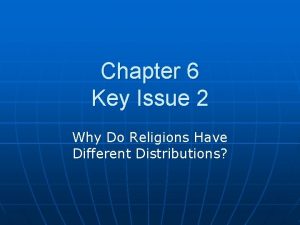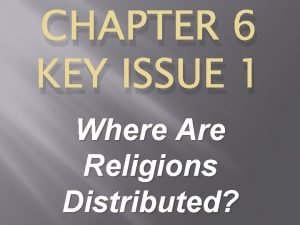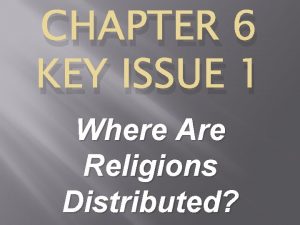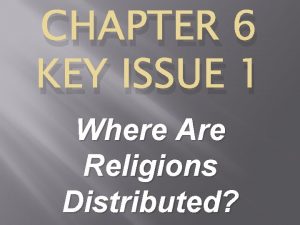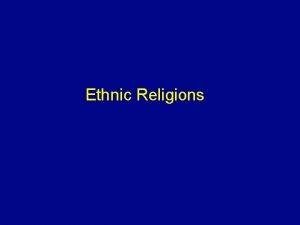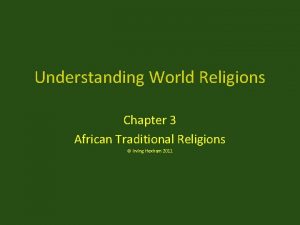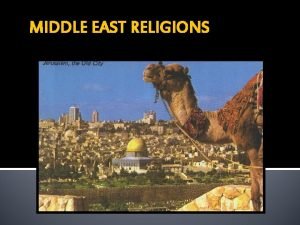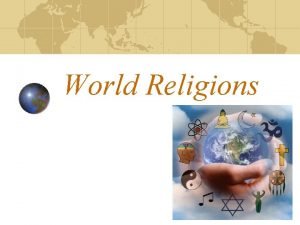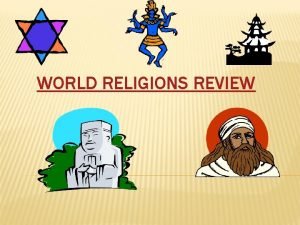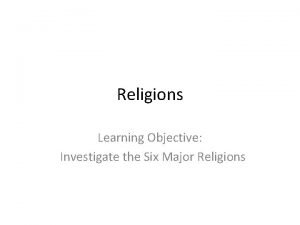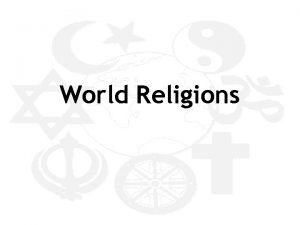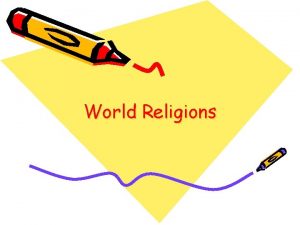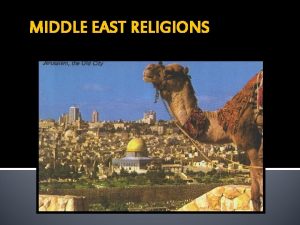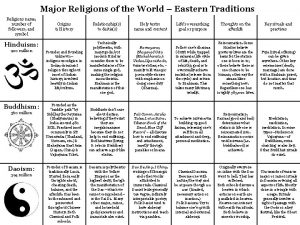CHAPTER 6 KEY ISSUE 2 Why do religions



































- Slides: 35

CHAPTER 6 KEY ISSUE 2 Why do religions have different distributions

BUDDHISM • Year of Origin: about 2500 years ago (Around 534500 BC) in Northeastern India/ Bangladesh • Founder: Siddhartha Gautama • Major Branches and Main Beliefs:

Siddhartha was a wealthy prince who wanted to learn more about the suffering he witnessed in the world. At 29, he left his privileged life behind and entered a forest where he remained for the next 6 years, emerging as the ‘Buddha, ’ or ‘enlightened one. ’ Siddhartha then spent the next 45 years spreading his message. Buddhists believe that suffering is prolonged through reincarnation, and that this can only be avoided by reaching a state of enlightenment called ‘nirvana. ’

• Theravada Buddhism: Means “the way of the elders” believe that they are closer to Buddha's original approach. Believe to become a Buddhist, one must renounce worldly goods and become a monk. Cite Buddha’s wisdom

MAHAYANA BUDDHISM: • Means “the great vehicle” Believe their approach can help more people because it is less demanding and all encompassing. Emphasize the importance of teaching and helping others. Cite Buddha’s compassion

VAJRAYANA BUDDHISM • Emphasize the practice of rituals known as Tantras. Vajrayana Buddhists believe the Buddha began practicing Tantras during his lifetime

CHRISTIANITY • Year of Origin: Around 2000 years ago • Founder: Jesus • Major Branches and beliefs:

• Jesus was born and raised Jewish but began a divine mission at age 29. He collected a group of followers, known as his disciples. • After two years, Jesus was betrayed by a disciple, Judas. He was crucified by the Romans in Jerusalem. Christians view Jesus’ death on the cross as a central event in their faith.

ROMAN CATHOLICISM • the oldest branch, and traces its roots to the time of the Roman Empire. • Follows the teachings of the Bible • Catholics follow a hierarchical order with the Pope on top, who the Catholics recognize as possessing a universal authority • God conveys His grace on Humanity through the Seven Sacraments. Baptism, the Eucharist, Penance, Confirmation, Matrimony, Holy Orders, and Anointing the Sick


ORTHODOX BRANCH • Comprised of the faith and practices of churches that arose in the eastern part of the Roman Empire • Disputes between Pope in Rome and Patriarch in Constantinople on authority and practices • broke away from Catholicism in the sixth century ce. Orthodox Christians follow the Seven Sacraments, but reject changes Catholicism has made


PROTESTANT BRANCH • traces its roots to the Reformation and Martin Luther’ 95 Theses. • Achieve personal salvation through direct communication with God • They believe salvation is achieved through faith rather than through religious sacraments • Unlike Catholics, Protestants believe that the Bible is the ultimate authority on Christianity, not the Pope or traditions of the Catholic Church

ISLAM Founded: ~1, 500 (7 th Century AD) years ago Founder: Prophet Muhammad

• Mohammad received visions from God (Allah) through the angel Gabriel at age 40. He began to articulate his visions in the Quran, gathering followers. • Mohammad and the first Muslims were kicked out of Mecca to Medina by its pagan rulers, but eventually they triumphantly returned to Mecca. Mohammad’s believers spread quickly through the Middle East and North Africa, uniting the many peoples they conquered under the banner of Islam.

SOME CORE BELIEFS • Practice the 5 Pillars of Faith • Shahadah- Declaring that there is only one God and Muhammad is the messenger of God • Salat- Pray 5 times a day facing Mecca • Zakat- Give generously to charity • Sawm of Ramadan- fast during the holy month of Ramadan as an act of self-purification • Hajj- A pilgrimage to Mecca (if physically and financially able to) • Holy book is the Quran


SUNNI AND SHIITE • The divide in Islam came almost immediately after Muhammad’s death. There were disagreements between who the rightful leader of Islam would be after the death of Muhammad • Sunni- The majority of Muslims are Sunni Muslims (about 85 -90%). Derived from the phrase “Ahl al-Sunnah” meaning “people of the tradition” Sunni Muslims recognize the first 4 Caliphs as the rightful successors of Muhammad (rightly guided Caliphs) • Shia (a Shiite is the adherent)- Dominant branch of Islam in Iran. (Formerly Persia) Shiite Muslims believe that Muhammad’s successor should be a relative of the prophet.

BUDDHISM IS BUILT AROUND “FOUR NOBLE TRUTHS” AS TAUGHT BY THE BUDDHA. SUMMARIZE THEM. • 1. All living things must endure suffering • 2. Suffering, caused by the desire to live, leads to reincarnation • 3. The goal is to escape suffering and reach Nirvana (a perfect understanding) through mental and moral self-Purification • 4. Nirvana is attained through the Eightfold Path: Rightness of belief, resolve, speech, action, livelihood, effort, thought, and meditation


HOW WAS ITS ORIGIN DIFFERENT THAN UNIVERSALIZING RELIGIONS? • Buddhism’s hearth is no longer where the practice is most popular

WHEN DID IT ORIGINATE? • 5 th Century BCE

WHERE DID IT ORIGINATE? • Northeastern India/ Bangladesh

WHAT TWO ANCIENT PEOPLES BELIEFS BLENDED TO FORM HINDUISM? • Hinduism existed before recorded history. Aryans, an indo-European tribe that migrated into South Asia, intermingled with the Davidians and modified their religious beliefs.


GIVE THREE EXPLANATIONS FOR THE DIFFUSION OF CHRISTIANITY • Relocation Diffusion- Christianity, like other universalizing religions, has been spread through MISSIONARIES, spreading Christianity to nearly all parts of the world • Expansion Diffusion- 2 different forms of expansion diffusion • Hierarchical Diffusion- Christianity was accepted by the Roman Emperor Constantine, who made it illegal to persecute Christians and encouraged people to convert Christianity. Emperor Theodosius made it the official religion of the Roman Empire • Contagious Diffusion- Christianity became widespread because of Missionary work and migration • (Christianity was the strongest institution that survived the fall of the Roman Empire. So it was the only thing that provided structure during an era of chaos in Europe)

GIVE THREE WAYS IN WHICH ISLAM SPREAD. • 1. Conquering land in Palestine, Persia & India- Muhammad’s successors organized followers into armies and conquered much of the Middle East, North Africa, and even Spain (Moors). • 2. Relocation diffusion by missionaries in Sub-Saharan Africa & S. E. Asia • 3. Arab traders in Indonesia

GIVE TWO REASONS FOR THE EXPANSION OF BUDDHISM. • At first, diffusion was slow. • Began to spread quickly through the Magadhan Empire during the reign of Emperor Asoka, who sent missionaries to spread Buddhism. later his son Mahinda led missionaries • Buddhism also spread via merchants on reliable trade routes throughout Asia. Many Chinese found Buddhist practices very appealing and Chinese emperors allowed their people to practice Buddhism.


Religions that have blended Christianity & African religions Buddhism & Shintoism Hinduism, Islam & Christianity Location Equatorial Guinea, Namibia & other African countries Japan Island of Mauritius

• NUMBER 11 -14 WAS SUPPOSE TO PREFACE WITH “IN REGARDS TO JUDAISM” BUT I THINK IT GOT CUT OFF

HOW IS ITS (JUDAISM) DISTRIBUTION VERY DIFFERENT FROM OTHER ETHNIC RELIGIONS? • The spatial distribution of Jews differs from other ethnic religions because it is practiced in many different places, not just at it’s hearth.

WHAT WAS THE DIASPORA? • When Romans forced Jews out of the Mediterranean after crushing their attempt to free themselves from Roman rule. Diaspora means dispersion • (At the time, Judaism’s practice of monotheism was considered illegal under Roman rule. )

HOW WERE MOST JEWS TREATED AS THEY LIVED AMONG OTHER NATIONALITIES? • Many Jews were persecuted and forced to live segregated from the rest of society. • Jews in Europe were not allowed to own land were banned from most jobs as well. One of the few jobs they could have was lending money with interest. • Jews were persecuted in Europe long before the Holocaust. Because they were the minority, they were often blamed for a societies problems. For example, when the Bubonic Plague hit Europe, many blamed it on the Jews saying that they had poisoned the water wells.

WHAT IS THE ORIGIN OF THE TERM GHETTO? • Neighborhood set up by law where Jews were required to live. It originated in the 6 th century in Venice, Italy as a reference to the city’s foundry, or metal casting district • Ghettos were surrounded by walls and the gates were locked at night to prevent escape
 Hearth of islam
Hearth of islam Why why why why
Why why why why Key issue 2: why are situation and site factors important?
Key issue 2: why are situation and site factors important? Key issue 1 why do services cluster downtown
Key issue 1 why do services cluster downtown Why are downtowns distinctive
Why are downtowns distinctive Key issue 4 why do countries face obstacles to development
Key issue 4 why do countries face obstacles to development Key issue 3 why do individual languages vary among places
Key issue 3 why do individual languages vary among places Key issue 4: why do people preserve local languages?
Key issue 4: why do people preserve local languages? Key issue 3 why do people migrate
Key issue 3 why do people migrate Why are different places similar geography
Why are different places similar geography Why are different places similar
Why are different places similar Key issue 3: why do people migrate?
Key issue 3: why do people migrate? Chapter 3 key issue 4
Chapter 3 key issue 4 Key issue 4 why do migrants face obstacles
Key issue 4 why do migrants face obstacles Key issue 3 why do some places face health challenges
Key issue 3 why do some places face health challenges Key issue 4 why are some human actions not sustainable
Key issue 4 why are some human actions not sustainable Key issue 3 why does population growth vary among regions
Key issue 3 why does population growth vary among regions Key issue 4 why are some actions not sustainable
Key issue 4 why are some actions not sustainable Why do religions organize space in distinctive patterns?
Why do religions organize space in distinctive patterns? Why do religions have distinctive distributions
Why do religions have distinctive distributions Judaism christianity and islam all began in southwest asia
Judaism christianity and islam all began in southwest asia Chapter 13 key issue 4
Chapter 13 key issue 4 Key issue 1: where are services distributed?
Key issue 1: where are services distributed? Chapter 12 key issue 1
Chapter 12 key issue 1 Chapter 11 key issue 4
Chapter 11 key issue 4 Language
Language Chapter 5 key issue 4
Chapter 5 key issue 4 Chapter 4 key issue 3
Chapter 4 key issue 3 Chapter 13 key issue 4
Chapter 13 key issue 4 Chapter 12 key issue 2
Chapter 12 key issue 2 Chapter 5 key issue 1 ap human geography
Chapter 5 key issue 1 ap human geography Chapter 6 key issue 4
Chapter 6 key issue 4 Chapter 5 key issue 2
Chapter 5 key issue 2 Chapter 4 key issue 2
Chapter 4 key issue 2 Chapter 2 key issue 2
Chapter 2 key issue 2 Chapter 2 key issue 1
Chapter 2 key issue 1
